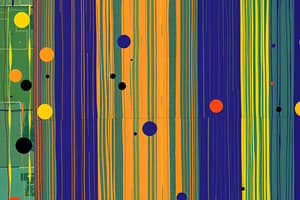Podcast
Questions and Answers
What is the primary goal of data preprocessing in machine learning?
What is the primary goal of data preprocessing in machine learning?
- To evaluate the model's performance
- To select the appropriate machine learning algorithm
- To gather the data from various sources
- To clean and prepare the data for analysis (correct)
Which step directly follows model selection in the machine learning process?
Which step directly follows model selection in the machine learning process?
- Feature extraction
- Model evaluation
- Model training (correct)
- Model preprocessing
What major issue arises from overfitting in machine learning models?
What major issue arises from overfitting in machine learning models?
- The model fails to learn from data
- The model cannot be interpreted easily
- The model performs well on training data but poorly on unseen data (correct)
- The model generates biased predictions
What is the purpose of feature engineering in machine learning?
What is the purpose of feature engineering in machine learning?
Which of these is NOT a challenge of machine learning?
Which of these is NOT a challenge of machine learning?
Why is model evaluation important in machine learning?
Why is model evaluation important in machine learning?
What is a critical factor in the success of a machine learning model?
What is a critical factor in the success of a machine learning model?
Which of the following accurately describes supervised learning?
Which of the following accurately describes supervised learning?
Which application is NOT typically associated with classification problems?
Which application is NOT typically associated with classification problems?
What does a classifier rely on to understand the relationship between input variables and the target variable?
What does a classifier rely on to understand the relationship between input variables and the target variable?
What type of classifier is appropriate when there are only two classes?
What type of classifier is appropriate when there are only two classes?
What characteristic of the K-Nearest Neighbor (K-NN) algorithm makes it a 'lazy learner'?
What characteristic of the K-Nearest Neighbor (K-NN) algorithm makes it a 'lazy learner'?
In what way does the K-NN algorithm operate when new data is introduced?
In what way does the K-NN algorithm operate when new data is introduced?
What type of problems can the K-NN algorithm be applied to?
What type of problems can the K-NN algorithm be applied to?
What distinguishes non-parametric algorithms like K-NN from parametric algorithms?
What distinguishes non-parametric algorithms like K-NN from parametric algorithms?
What is one of the main reasons for using K-NN in image classification tasks?
What is one of the main reasons for using K-NN in image classification tasks?
What are support vectors in the context of SVM?
What are support vectors in the context of SVM?
What is the goal of the SVM algorithm?
What is the goal of the SVM algorithm?
How does the SVM algorithm handle non-linear data?
How does the SVM algorithm handle non-linear data?
Which statement best describes the optimal hyperplane in SVM?
Which statement best describes the optimal hyperplane in SVM?
What is a characteristic of machine learning systems?
What is a characteristic of machine learning systems?
Which factor is crucial for the performance of a machine learning model?
Which factor is crucial for the performance of a machine learning model?
What do SVM algorithms utilize to find the best decision boundary?
What do SVM algorithms utilize to find the best decision boundary?
What mathematical operation is suggested to create a third dimension z for non-linear data?
What mathematical operation is suggested to create a third dimension z for non-linear data?
What is the primary purpose of the K-Means clustering algorithm?
What is the primary purpose of the K-Means clustering algorithm?
Which step in the K-Means algorithm involves assigning data points to the nearest centroid?
Which step in the K-Means algorithm involves assigning data points to the nearest centroid?
In the context of machine learning, what is a key characteristic of unsupervised learning?
In the context of machine learning, what is a key characteristic of unsupervised learning?
What does the 'Update Step' in K-Means entail?
What does the 'Update Step' in K-Means entail?
How does identifying patterns in data benefit decision makers?
How does identifying patterns in data benefit decision makers?
Which of the following statements is true about the convergence of the K-Means algorithm?
Which of the following statements is true about the convergence of the K-Means algorithm?
What aspect does the ‘training and testing’ phase of a machine learning model evaluate?
What aspect does the ‘training and testing’ phase of a machine learning model evaluate?
What is a common distance metric used in K-Means for assigning points to centroids?
What is a common distance metric used in K-Means for assigning points to centroids?
What type of learning is based on training a model on labeled data?
What type of learning is based on training a model on labeled data?
Which of the following is an example of unsupervised learning?
Which of the following is an example of unsupervised learning?
What is semi-supervised learning primarily used for?
What is semi-supervised learning primarily used for?
In reinforcement learning, how does an agent learn optimal strategies?
In reinforcement learning, how does an agent learn optimal strategies?
What is the main characteristic of supervised learning?
What is the main characteristic of supervised learning?
Which type of machine learning is best suited for tasks involving optimal decision-making?
Which type of machine learning is best suited for tasks involving optimal decision-making?
Which statement about unsupervised learning is true?
Which statement about unsupervised learning is true?
What distinguishes semi-supervised learning from supervised learning?
What distinguishes semi-supervised learning from supervised learning?
Flashcards are hidden until you start studying
Study Notes
Natural Language Processing
- Machine learning enhances language translation, sentiment analysis, chatbots, and virtual assistants, facilitating intuitive human-computer interactions.
Types of Machine Learning
- Supervised Learning: Involves training on labeled data; useful for classification and regression tasks. Example: Handwriting recognition classifies handwritten digits.
- Unsupervised Learning: Deals with unlabeled data, identifying patterns or clusters without explicit guidance. Example: Customer segmentation groups similar purchasing behaviors.
- Semi-Supervised Learning: Combines labeled and unlabeled data for predictions. Example: Sentiment analysis uses a small set of labeled reviews for classifier training.
- Reinforcement Learning: An agent learns from interactions with an environment, receiving feedback through rewards or penalties. Example: AI in games learns optimal strategies over time.
Machine Learning Modeling Flow
- Data Collection: Gathering relevant data from various sources is essential for model success.
- Data Preprocessing: Cleaning and transforming data to ensure its suitability for analysis.
- Feature Engineering: Selecting and extracting relevant features significantly influences model performance.
- Model Selection: Choosing the appropriate algorithm based on data characteristics and problem requirements.
- Model Training: The algorithm learns patterns and relationships from labeled data.
- Model Evaluation: Assessing the model's ability to generalize on unseen data.
- Model Tuning: Adjusting hyperparameters to improve accuracy and generalization.
Challenges of Machine Learning
- Data Quality: Poor or biased data leads to unreliable models; high-quality data is crucial.
- Overfitting: Occurs when models perform well on training data but poorly on new data; strategies are needed to prevent this.
- Interpretability: Complex models may be hard to interpret; important for applications requiring transparency.
Examples of Classification Problems
- Applications: Speech recognition, face detection, spam email classification, stock market prediction, breast cancer detection, employee attrition prediction.
Classification Algorithms
- Classifiers utilize training data to understand relationships between independent and dependent variables; used to predict outcomes like weather conditions based on past data.
- Binary classifiers handle two classes, while multi-class classifiers manage multiple classes.
K-Nearest Neighbor (KNN) Algorithm
- A simple supervised learning algorithm that classifies new data based on similarity to stored cases.
- KNN is non-parametric and does not assume underlying data distribution; operates by comparing features of new data against known categories.
Support Vector Machines (SVM)
- Support Vectors: Closest data points to the hyperplane that influence its position.
- SVM finds the optimal hyperplane to separate data classes by maximizing the margin between them.
- For non-linear data, an additional dimension may be used to achieve separation.
Unsupervised Learning Definition and Characteristics
- Definition: ML enables computers to perform tasks using patterns derived from data without explicit instructions.
- Key Characteristics:
- Data-driven approach reliant on quality data.
- Utilizes various algorithms for model building and predictions.
- Emphasizes training and testing for model evaluation.
Applications of Pattern Discovery
- Identifying trends and correlations allows decision-makers to derive insights in fields like banking, healthcare, and marketing.
- Recognizing patterns provides predictive capabilities regarding future events.
- Understanding trends helps forecast outcomes based on temporal data analysis.
K-Means Clustering Algorithm
- A popular clustering method that partitions datasets into K distinct, non-overlapping clusters.
- Process Overview:
- Initialize K centroids.
- Assign data points to the nearest centroid.
- Update centroids based on assigned points' means.
- Repeat until centroid positions stabilize, achieving convergence.
Studying That Suits You
Use AI to generate personalized quizzes and flashcards to suit your learning preferences.




